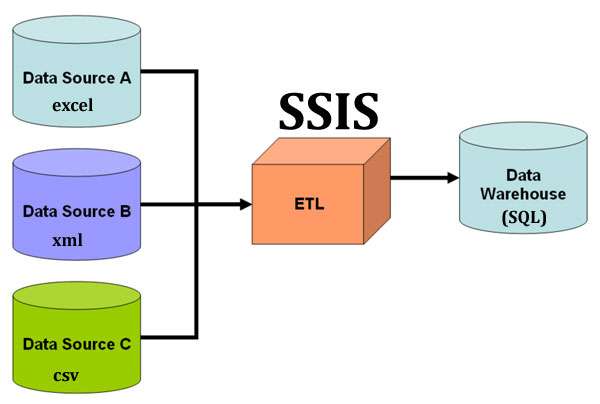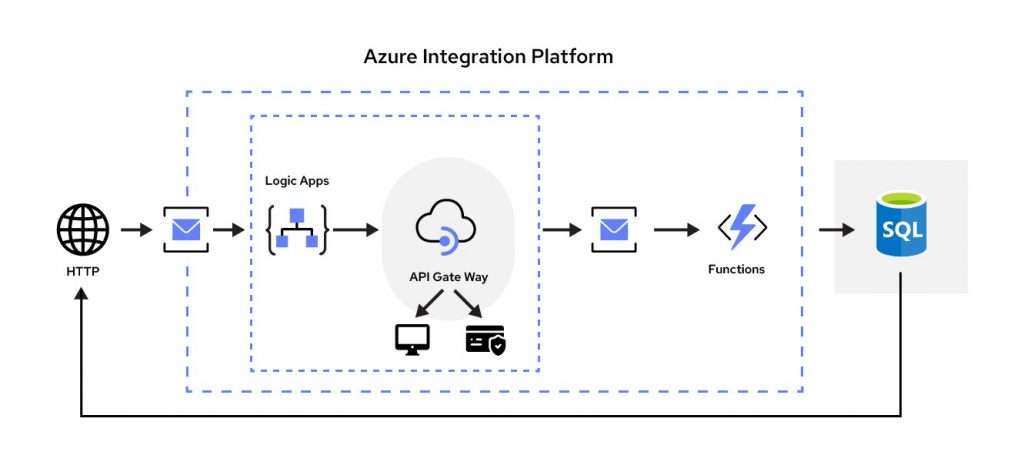
- Introduction to Data Integration Tools
- Overview of Azure Data Factory
- Overview of SQL Server Integration Services (SSIS)
- Overview of Azure Databricks
- Architecture and Workflow
- Performance and Scalability Differences
- Integration with Other Azure Services
- Security and Compliance Comparison
- Cost and Licensing Considerations
- Use Cases for Each Tool
- Choosing the Right Tool for Your Business
- Future Trends in Data Integration Technologies
- Conclusion
Introduction to Data Integration Tools
Data integration integrates data from various sources into a single view, enabling more effective analysis and decision-making. Several tools can streamline and automate this process, each appropriate for different requirements depending on the data type, infrastructure, and the organization’s needs. Three popular data integration tools are Azure Data Factory (ADF), SQL Server Integration Services (SSIS), and Azure Databricks. These tools offer a distinctive data integration methodology with different performance, scalability, price, and usability strengths. The article will compare the three tools and assist you in selecting the correct one according to your business needs.
Overview of Azure Data Factory
Azure Data Factory (ADF) is a cloud-based data integration service provided by Microsoft Azure. It enables organizations to create, schedule, and orchestrate data workflows, which can process data from various sources, transform it, and load it into a target data store or analytics platform.
Key Features of Azure Data Factory:- Cloud-Native: ADF is fully cloud-based, making it ideal for organizations that want to process data in the cloud without managing on-premises infrastructure.
- ETL/ELT Capabilities: ADF supports ETL (Extract, Transform, Load) and ELT (Extract, Load, Transform) processes, offering flexibility in how data is moved and transformed.
- Pipeline Orchestration: Data pipelines can be designed visually and automated, supporting the entire data processing lifecycle.
- Integration with Azure Services: ADF integrates seamlessly with other Azure services, such as Azure Synapse Analytics, Azure SQL Database, and Azure Blob Storage.
- Scalability and Performance: ADF offers scalable data processing and orchestration, handling large data volumes and complex workflows.
- Built-In Monitoring: ADF comes with integrated monitoring features that track the health and performance of data pipelines.
Overview of SQL Server Integration Services (SSIS)
SQL Server Integration Services (SSIS) is a robust data integration tool within the Microsoft SQL Server ecosystem, designed for ETL (Extract, Transform, Load) operations. It allows organizations to extract data from multiple sources, transform it as needed, and load it into data warehouses or other destinations. While SSIS can run in the cloud, it is primarily used in on-premises environments. With strong ETL capabilities, it provides a reliable platform for data extraction, cleansing, transformation, and loading. Its deep integration with SQL Server makes it a preferred choice for businesses relying on SQL Server for data storage and analytics. SSIS includes a rich set of built-in transformations and components, enabling seamless data processing. Furthermore, it offers advanced error handling and logging features, ensuring efficient troubleshooting and effective data pipeline management.

Overview of Azure Databricks
Azure Databricks is an Apache Spark-based analytics platform optimized for the Microsoft Azure cloud. It is designed to provide a unified analytics platform for data engineers, data scientists, and analysts. Databricks combines the power of Apache Spark with the scalability and flexibility of Azure, enabling the integration, preparation, and analysis of big data.
Key Features of Azure Databricks:- Big Data Processing: Azure Databricks leverages Apache Spark to handle large-scale data processing and analytics workloads. It is designed for real-time and batch processing of big data.
- Unified Workspace: The platform provides a collaborative workspace for data engineers and data scientists, where they can run notebooks, build data pipelines, and share results.
- Integration with Azure Services: Databricks integrates well with Azure storage, SQL, and Azure Machine Learning, providing a seamless end-to-end analytics solution.
- Advanced Analytics and Machine Learning: In addition to traditional ETL tasks, Databricks supports advanced analytics, machine learning workflows, and deep learning integration.
- Performance and Scalability: Databricks offer robust scalability, enabling efficient processing of massive datasets with low-latency performance.
Architecture and Workflow
Azure Data Factory (ADF), SQL Server Integration Services (SSIS), and Azure Databricks are three distinct data integration and processing tools, each catering to different needs. ADF is a fully managed, cloud-based service that integrates seamlessly with Azure data services, making it ideal for cloud workloads. It supports both ETL and ELT workflows and offers advanced data transformation capabilities, including machine learning and custom scripting. SSIS, primarily an on-premises solution, can also be deployed in the cloud. It is closely integrated with SQL Server and specializes in ETL processes, providing scalable solutions within on-premises environments. Azure Databricks, built on Apache Spark, is a cloud-based platform designed for big data processing, advanced analytics, and real-time data workflows. It integrates tightly with Azure storage, SQL, and machine learning services, offering high scalability for complex data workloads. While ADF is best suited for cloud-based integration, SSIS excels in traditional ETL tasks, and Azure Databricks is ideal for big data and analytics-driven applications.
Performance and Scalability Differences
Azure Data Factory (ADF)- Scalability: ADF can handle large-scale cloud-based data pipelines with automatic scaling to meet the performance demands of high-throughput environments.
- Performance: While ADF is highly efficient for orchestrating data workflows, the performance of data transformation depends on the compute resources allocated to the pipeline. SQL Server Integration Services (SSIS)
- Scalability: SSIS is scalable within on-premises environments, but scaling is limited compared to cloud-native solutions like ADF or Databricks.
- Performance: SSIS is well-optimized for SQL Server environments and can handle high-throughput data transfers within on-premises ecosystems. Azure Databricks
- Scalability: Databricks leverages Apache Spark’s distributed computing power, making it ideal for big data workloads and highly scalable environments.
- Performance: Databricks provides fast processing for large datasets, is designed for batch and real-time processing, and offers low-latency performance for analytics.
Integration with Other Azure Services
- Azure Data Factory integrates seamlessly with a wide range of Azure services such as Azure Synapse Analytics, Azure SQL Database, Azure Blob Storage, Azure Machine Learning, and Azure Databricks.
- SQL Server Integration Services is tightly integrated with SQL Server and can connect to various external sources, including cloud databases and on-premises data sources.
- Azure Databricks integrates deeply with Azure Storage, Azure SQL, and Azure Machine Learning services, offering a comprehensive analytics and machine learning solution.

Security and Compliance Comparison
Azure Data Factory (ADF), SQL Server Integration Services (SSIS), and Azure Databricks implement strong security measures to ensure data protection and compliance. ADF adheres to security standards such as GDPR, SOC 1, SOC 2, and ISO 27001, with data encryption both in transit and at rest. It also supports role-based access control (RBAC) to enhance data pipeline security. SSIS secures sensitive data through encryption and integrates authentication and authorization features within SQL Server. It supports Windows-based security models and can be used with Active Directory for access control. Azure Databricks follows Azure’s security framework, encrypting data at rest and in transit while also supporting RBAC for secure access. Additionally, it integrates with Azure Active Directory for authentication.
Cost and Licensing Considerations
Azure Data Factory (ADF), SQL Server Integration Services (SSIS), and Azure Databricks have distinct pricing models based on their deployment and resource consumption. ADF pricing depends on the number of data pipeline activities, data movement, and transformations, with additional costs for computing resources such as Azure Databricks or HDInsight and storage usage. SSIS is typically licensed as part of the SQL Server package, but organizations must also consider infrastructure costs, including servers, for on-premises deployment. Azure Databricks follows a usage-based pricing model, where costs are determined by the computing and storage resources consumed. It offers flexible pricing based on cluster usage and the required level of performance, allowing businesses to scale resources as needed.
Use Cases for Each Tool
- Azure Data Factory: Best suited for cloud-based ETL/ELT workflows, orchestration of data pipelines, and integration of multiple Azure services. Ideal for companies looking for a scalable, fully managed solution to move data across various cloud environments.
- SQL Server Integration Services (SSIS): Well-suited for businesses with existing SQL Server environments and must perform complex ETL processes on-premises. Ideal for organizations that require tight integration with SQL Server and prefer to manage their data integration workflows on-premises.
- Azure Databricks: These are perfect for organizations with big data or advanced analytics, especially those requiring machine learning and real-time data processing capabilities. They are suitable for healthcare, retail, and finance businesses, where large-scale analytics are crucial.
Choosing the Right Tool for Your Business
- Choose Azure Data Factory if your organization primarily focuses on cloud-based data integration, automation, and orchestration of data workflows across various Azure services.
- Choose SQL Server Integration Services (SSIS) if your organization relies on on-premises SQL Server environments and requires robust ETL capabilities within that ecosystem.
- Choose Azure Databricks if your organization needs to process large datasets, perform real-time analytics, or run machine learning workflows on top of significant data infrastructure.
Future Trends in Data Integration Technologies
- Cloud-Native Solutions: As organizations move to the cloud, cloud-native data integration tools like ADF will continue to gain popularity due to their flexibility, scalability, and cost-effectiveness.
- AI and Machine Learning: Integrating AI and machine learning capabilities into data integration tools will enable more intelligent data processing, such as automated data cleaning, anomaly detection, and predictive analytics.
- Real-Time Data Integration: As more businesses move towards real-time analytics, data integration tools like Azure Databricks will continue to evolve to support real-time data streaming and processing.
Conclusion
Choosing the correct data integration tool depends on your organization’s needs, existing infrastructure, and long-term goals. Azure Data Factory offers a cloud-native, scalable solution for data workflows. SQL Server Integration Services (SSIS) is best suited for SQL Server-based on-premises environments. and Azure Databricks is ideal for big data processing and advanced analytics. By understanding the strengths of each tool, businesses can make more informed decisions about how to manage and integrate their data efficiently.





